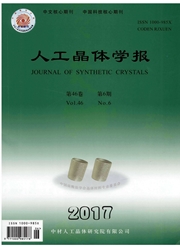

 中文摘要:
中文摘要:
基于密度泛函理论第一性原理研究了BiOCl(110)表面两种不同终止端(110)-BiCl和(110)-O电子结构和光吸收性质。结果表明:(110)-BiCl和(110)-O表面均未发生重构现象;(110)-BiCl表面导带底部出现明显表面态,导致该表面带隙降低,且价带与导带均朝低能方向移动;而(110)-O表面态位于价带顶,导带能带变窄导致该表面带隙略大于体相BiOCl;(110)-BiCl和(110)-O表面能分别为1.570J·m-2和1.550J·m-2;光吸收性质对比分析知,与BiOCl体相相比,(110)-BiCl表面吸收光谱发生明显红移。
 英文摘要:
英文摘要:
The electronic structure and optical absorption of two different terminations ((110)-BiCl and (110)-O) for BiOCl (110 ) surfaces were calculated by the first-principles based on density functional theory. The results indicate that there is no obvious reconstruction for BiOCl(110) surfaces. For (110)- BiCl surface, surface states are located at the bottom of conduction band, reducing the band gap, and both the conduction and valence band of (110)-BiCl surface shift towards the lower energy. However, there exist surface states at the top of valence band of (110)-O surface, and the band gap of (110)-O surface is slightly wider than that of the bulk. Furthermore, the surface energies of ( 110 )-BiCl and (110)-O are 1. 570 J·m-2 and 1. 550 J · m-2, respectively. Compared with the optical absorption spectra of BiOCl(110) surface and bulk phase BLOC1, it is found that there is an obvious red-shift for (110) -BiCl surface.
 同期刊论文项目
同期刊论文项目
 同项目期刊论文
同项目期刊论文
 Electronic structures and optical properties of transition metals (Fe, Co, Ni, Zn) doped rutile TiO2
Electronic structures and optical properties of transition metals (Fe, Co, Ni, Zn) doped rutile TiO2 Preparation and photocatalytic properties of ilmenite NiTiO3 powders for degradation of humic acid i
Preparation and photocatalytic properties of ilmenite NiTiO3 powders for degradation of humic acid i A dual chelating sol-gel synthesis of BaTiO3 nanoparticles with effective photocatalytic activity fo
A dual chelating sol-gel synthesis of BaTiO3 nanoparticles with effective photocatalytic activity fo First-principles investigation of impurity concentration influence on bonding behavior, electronic s
First-principles investigation of impurity concentration influence on bonding behavior, electronic s First-principles study on the structural, electronic and optical properties of BiOX (X=Cl, Br, I) cr
First-principles study on the structural, electronic and optical properties of BiOX (X=Cl, Br, I) cr Low temperature one-step synthesis of rutile TiO2/BiOCl composites with enhanced photocatalytic acti
Low temperature one-step synthesis of rutile TiO2/BiOCl composites with enhanced photocatalytic acti Facile preparation of Sn-doped BiOCl photocatalyst with enhanced photocatalytic activity for benzoic
Facile preparation of Sn-doped BiOCl photocatalyst with enhanced photocatalytic activity for benzoic DFT+U predictions: The effect of oxygen vacancy on the structural, electronic and photocatalytic pro
DFT+U predictions: The effect of oxygen vacancy on the structural, electronic and photocatalytic pro Synthesis of BiOCl photocatalyst by a low-cost, simple hydrolytic technique and its excellent photoc
Synthesis of BiOCl photocatalyst by a low-cost, simple hydrolytic technique and its excellent photoc Effect of light response on the photocatalytic activity of BiOCl (x) Br1-x in the removal of Rhodami
Effect of light response on the photocatalytic activity of BiOCl (x) Br1-x in the removal of Rhodami One-step synthesis of porous BiOBrfilm and Bi nanopowder simultaneously from Bi plate via electroche
One-step synthesis of porous BiOBrfilm and Bi nanopowder simultaneously from Bi plate via electroche Photocatalytic degradation of carbamazepine using hierarchical BiOClmicrospheres: Some key operating
Photocatalytic degradation of carbamazepine using hierarchical BiOClmicrospheres: Some key operating Effect of chlorine ion on the crystalline and photocatalytic activityof BiOCl for the degradation of
Effect of chlorine ion on the crystalline and photocatalytic activityof BiOCl for the degradation of An in vitro study on the cytotoxicity of bismuth oxychloride nanosheets in human HaCaT keratinocytes
An in vitro study on the cytotoxicity of bismuth oxychloride nanosheets in human HaCaT keratinocytes Rapid synthesis of hierarchical BiOCl microspheres for efficient photocatalytic degradation of carba
Rapid synthesis of hierarchical BiOCl microspheres for efficient photocatalytic degradation of carba A BiPO4/BiOCl heterojunction photocatalyst with enhanced electron-hole separation and excellent phot
A BiPO4/BiOCl heterojunction photocatalyst with enhanced electron-hole separation and excellent phot A facile approach for the tunable fabrication of BiOBr photocatalysts with high activity and stabili
A facile approach for the tunable fabrication of BiOBr photocatalysts with high activity and stabili One-pot hydrothermal synthesis of a novel BiPO4/BiOBrcomposite with enhanced visible light photocata
One-pot hydrothermal synthesis of a novel BiPO4/BiOBrcomposite with enhanced visible light photocata Comparative toxicities of bismuth oxybromide and titanium dioxideexposure on human skin keratinocyte
Comparative toxicities of bismuth oxybromide and titanium dioxideexposure on human skin keratinocyte Double Br sources fabrication and photocatalytic property of p-n junction BiOBr/ZnO composites for p
Double Br sources fabrication and photocatalytic property of p-n junction BiOBr/ZnO composites for p Effect of chlorine ion on the crystalline and photocatalytic activity of BiOCl for the degradation o
Effect of chlorine ion on the crystalline and photocatalytic activity of BiOCl for the degradation o 期刊信息
期刊信息
